On August 23 I finished the seven-panel plein air oils of The Diamond Grade. On September 10, I’m still working on putting together a small card with a fold-out version of the panorama. This is a project I thought to complete in a couple of hours. Instead, it’s taken weeks.
There was the question of the size of the images. And the paper onto which they would be printed. And which printer. And then it was clear that without some kind of cover, the images, folded into rectangles, looked a bit like the notes I passed to friends as a sixth-grader. So I had to find a cover. And then the images sprang open inside the cover, so I had to find a way to fasten the cover, a way which could be undone and redone, without too much damage. I had a bunch of Moo cards that I am currently enamored of that I wanted to include somehow.
Here’s the photo essay of the process:
The original strip of images:

After trying out samples of 3″ and 4″ sizes on my HP ink jet printer and 2″ sizes on my Epson pigment printer, which actually could handle up to 24-inch wide strips, I decided to go with Kinko’s laser printing service.
Now I want a laser printer.
I needed to identify the images (and myself as maker of them) with some text and ultimately consulted with a graphic designer and good friend. Good thing I did, too. She’s the one who got me to Kinko’s, who made up the pdf file for Kinko’s, who suggested a fine font, and who resized slightly the images to get the most for my money. A good professional is worth a thousand painful choices.

Then there was the cover. I decided on a stiff polyester interfacing called lutradur, which looks a bit like rice paper:
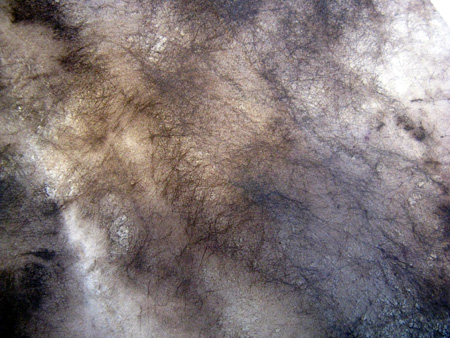
I had lots of the stuff, but most of it was white and I like the way it takes fabric paint. To get this effect, one (“one” meaning me) spreads out the folded lutradur on a table, brushes the fabric paint over it, sloshes on water so the paint goes through the layers underneath, puts on more paint, sprays on more water, a bit more paint here and there, and then realizes that all four sides of the table are pouring down water and fabric paint. There’s a reason my studio has ugly plywood floors — so I can decorate it with sloshes of over-runs.
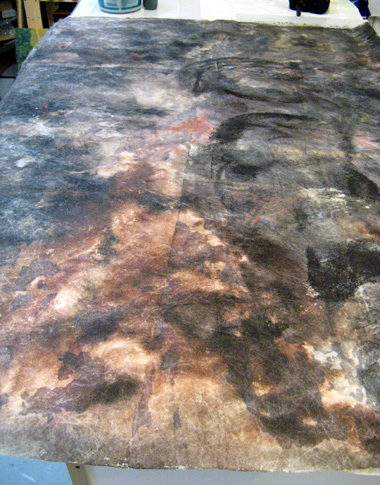
Having cleaned up the floor mess, I went back to thinking about the covers and decided to try some other papers I had stored around the house.
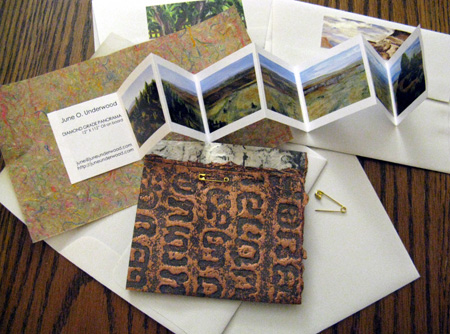
Although some worked ok, the most serviceable was still the lutradur. Then the fastening of the card, so the folded strips didn’t sprong open, became an issue. After trying a variety of techniques, all dorky, I decided that PoMo (Post-Modernism) would allow for one satiric element — a safety pin closure with the Moo Card on the outside of the envelope.

Yelps of outrage over the safety pin from both Jer and Terry, the graphic artist, sent me spinning again. It had been at least 3 weeks into this project and here I was, circling, again. I dug in my heels, scowled, sulked, grumped (but only to myself in the privacy of my studio) when Terry saved the day again.
This is something like the final product, with a even more elegant fastener yet to be inserted (she said with eternally springing hope):
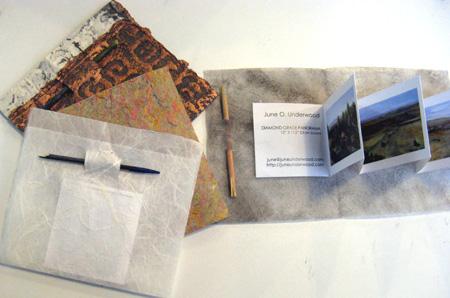
These are the latest versions, with the lutradur one open, and the samples of other paper covers shown. The broken skewers, found in the basement as 2 foot long rods, will be replaced by something called “Interdental Stimulators”, which sounds silly and satisfies my PoMo irony entirely. They also look elegant, like flat bamboo fasteners. Another Terry find. Jer is out looking to buy them at this very moment.
And so is (almost) finished the tale of three weeks work on a two hour project. Done with a little help from my friends. I don’t know if I engaged in the project because I really really wanted to make these dudes or because after the intense painting in the Oregon desert, I wanted to procrastinate and not paint again.
Tell me, do any of you engage in two-hour projects that take 3 weeks and hundreds of bad decisions (before reaching good ones)? And why do we collectively engage in these kinds of frustrating, perhaps failing, efforts, which cause us to rend our hair and irritate our loved ones? Is it neurology, biology, or stupid stubbornness?
And the PS you were waiting for: Rite Aid has discontinued its elegant wooden Interdental Stimulators for depressing (and probably more dentally effective) white plastic ones. Jer did find some smaller wooden versions that will work, if, when I immerse them in a bit of watered down paint to get rid of the hideous orange color, they don’t disintegrate. I swear — today is the last day I’m going to work at this project — except for the production line (me, myself, and I) cutting the strips, gluing them down, gluing on the moo card, and inserting (hopefully) the wooden flats.
Anybody want a card?
PPS:

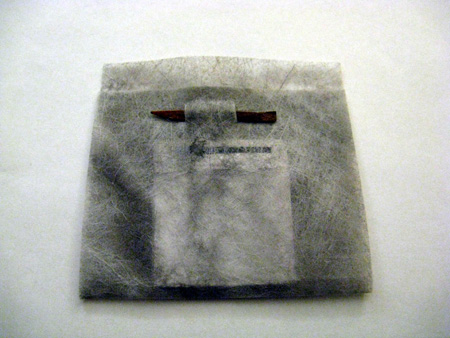
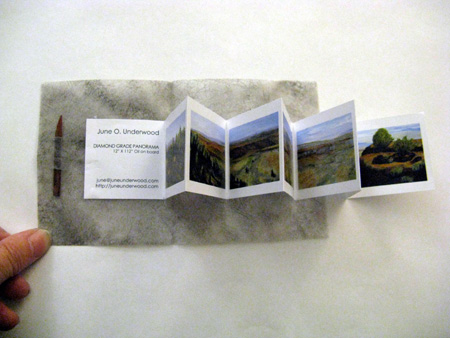
Aaaaahhhhhhhhhh!

June:
Sign me up.
June,
What a wonderful material lutradur must be to allow such great coloring.
Please sign me up too.
You are both on my list!
Here’s a link to an information site and a booklet for sale about lutradur:
http://www.squidoo.com/lovelylutradur
Full disclosure: The authors are friends of mine. That’s how I got started with the stuff.
June:
Received your “small project” in the mail today. The formal qualities are remarkable. I love the panorama format. I am required to focus down on a depiction of something very broad. Opening the folder, unfolding the picture segments, holding the whole thing in my hands, bring to bear a medley of associations including the memory of those little folding postcards that I encountered as a kid in Amsterdam – examples of which I could likely find in a box in the attic. The very fact of the format pulls a number of feelings from my data bank that then soak into your desert.
The printing turns out to be sharp and authoritative. It makes me think that your panoramas may be at their best at this scale – but this may be but one instance of a good size.
I’m still thinking about the lutradur (not capitalized?) folder. The packet of images is veiled by this semitransparent material and presents a ‘mysteries awaiting within’ quality. All vagueness dissipates upon opening. I wonder what the separate elements would like if each were mounted on the lutradur without any white borders.
And a tip of the hat to Jer for his finding those Stim-U-Dents. They took me off in a false expectation as I was equating them in size with chop sticks – don’t ask me why.
And thanks so much for sharing these lovely (insert proper French term).
Yes, I get involved in all manner of things that balloon unexpectedly.
Thank you, Jay, for such lovely compliments. I’m glad the packet sings that good medley. I was surprised that the panorama looked so good at that size — originally I had thought to make them 3 or 4 inches in height. But the smaller sizes had an unexpected charm (as well as an unexpected monetary savings).
Now as for your suggestion about the lutradur — I’m not quite envisioning what you had in mind, and I think I won’t try to –snort — This is a project that needs closure. Sending it along brings that, no? But if you want to try something more with it, I’ll be glad to provide you with some raw materials and you can have a go at it.
I’m going to have a go at a big (4′ x 5′) linen canvas tomorrow — I think I actually understand what that will involve pretty well.
June:
There’s a Joanne Fabric place nearby. Chances are that they sell the stuff. Actually, I would be trying to commit an atrocity. I have made a few halfhearted attempts to bond plexiglas to paper and fabric using heat. It has worked kinda, but a fabric that is thin, flexible and has little or no directionality might be kinda better. The idea would be to work up a pattern or design on the lutradur, lay a sheet of plexiglas over and hit it with my propane weed burner. The whole thing may be ugly as sin – but who knows?
A 4′ x 5′ linen canvas? You rich or something?
There was or may still be a gallery at the Baltimore Museum of Art that featured a neon assemblage against one wall, spelling out the word “WAR”. It seemed to be a statement agin’ it. On another wall was one of those Andy Warhol self portraits. The room deserved to be called the Anti War Hall.
Jay,
I doubt that Joanne’s has lutradur — I remember having to Google and then order it online. However, _I_ have lutradur. If you don’t mind a drip or ten of fabric paint (I don’t think I have any that hasn’t been mucked with), I’d be glad to send you a batch to play with. I think it shrivels with heat.
Another fabric-like material that textile artists play with is Tyvek. It is white rather than translucent, but apparently does all kinds of nice warping when heated. A warning — the tyvek used for siding isn’t good to use — it’s impregnated with bad stuff and doesn’t work well. The tyvek that the US Post Office makes its bags out of is better. If you have some used PO bags to play with and you like it and want more, I can find sources for more of the stuff that isn’t “adulterated.”
So let me know if you want some lutradur. I’ll stuff it in a PO Tyvek bag and send it off. You are using a respirator when you propane this stuff, right?
As for the linen — it was spendy, but less so in a roll than otherwise. It was on sale at Art Supply Warehouse. It’s such lovely stuff that I may never be able to go back to canvas. Luckily, I really like working on masonite panels, so I can avoid the linen except when I get struck with a grandiose project, like the desert project.
And, m’dear, I did groan mightily at your BMA pun. I gather from my punster friends that the louder the groan, the mightier the pun.
June,
I relate to your images so much better now that I see them displayed in a panoramic fashion on paper rather than electronically. The colors are more vibrant and the panoramic view is magnificent. Thanks a million. It was also magic touching something that you had touched. So much is lost internetting.
Inspired by you, I visualized a Great Lake panorama from the dunes this weekend – separate paintings portraying the left coast line, two islands in the distance and the right coast line.
Thank you, Birgit. You are right about the internet, particularly with something like the panoramas. It’s also bad for big pieces of art — they get reduced. On the other hand, the web and computers are wonderful for photos and for small, intricate artworks. I can sometimes see things on my computer that completely pass me by in person.
A Great Lake panorama seems most appropriate — and full of wonderful challenges of color and value. I have two small panos in the studio right now, one with horizontal panels, the other with vertical panels. I’m trying to evaluate the differences. A bit like your work with different ratios. The difference in orientation (same ratios, turned 90 degrees) makes for startling differences in what one has to do with the painting. Well, maybe not startling, unless you are the painter and have to figure out what to do as well as what the problems might be. And what the gains, also.
June,
I was able to show your seven panels to Troels who visited with me ‘up North’ where I had left them.
He enjoyed them very much, particulary the 6th panel. He very much liked its colors.
Finally, he told me ‘How good to have friends’. Thank you again.
Birgit,
Thank you. I’ve been snowed under (literally a couple of times) and so didn’t have a chance to respond earlier. I trust Troels’ evaluation (after all, he is with you, isn’t he, which just goes to show his good taste….)
It is good to have friends and surprising to have these “virtual” friends, who share their thoughts and talents. Although, in person, whether art or friends, might be a whole lot better.